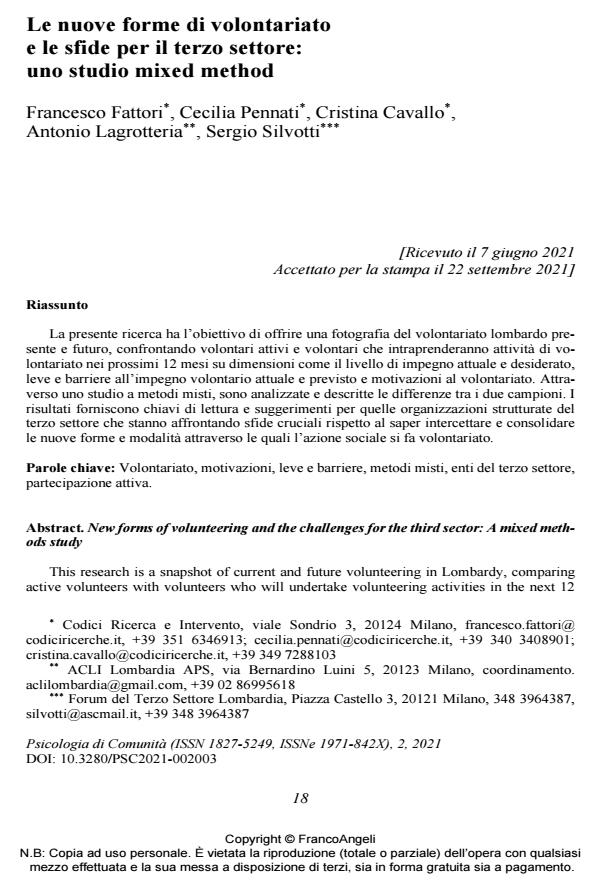Le nuove forme di volontariato e le sfide per il terzo settore: uno studio mixed method
Titolo Rivista PSICOLOGIA DI COMUNITA’
Autori/Curatori Francesco Fattori, Cecilia Pennati, Cristina Cavallo, Antonio Lagrotteria, Sergio Silvotti
Anno di pubblicazione 2021 Fascicolo 2021/2
Lingua Italiano Numero pagine 24 P. 18-41 Dimensione file 315 KB
DOI 10.3280/PSC2021-002003
Il DOI è il codice a barre della proprietà intellettuale: per saperne di più
clicca qui
Qui sotto puoi vedere in anteprima la prima pagina di questo articolo.
Se questo articolo ti interessa, lo puoi acquistare (e scaricare in formato pdf) seguendo le facili indicazioni per acquistare il download credit. Acquista Download Credits per scaricare questo Articolo in formato PDF

FrancoAngeli è membro della Publishers International Linking Association, Inc (PILA)associazione indipendente e non profit per facilitare (attraverso i servizi tecnologici implementati da CrossRef.org) l’accesso degli studiosi ai contenuti digitali nelle pubblicazioni professionali e scientifiche
La presente ricerca ha l’obiettivo di offrire una fotografia del volontariato lombardo pre-sente e futuro, confrontando volontari attivi e volontari che intraprenderanno attività di volontariato nei prossimi 12 mesi su dimensioni come il livello di impegno attuale e desiderato, leve e barriere all’impegno volontario attuale e previsto e motivazioni al volontariato. Attraverso uno studio a metodi misti, sono analizzate e descritte le differenze tra i due campioni. I risultati forniscono chiavi di lettura e suggerimenti per quelle organizzazioni strutturate del terzo settore che stanno affrontando sfide cruciali rispetto al saper intercettare e consolidare le nuove forme e modalità attraverso le quali l’azione sociale si fa volontariato.
Parole chiave:Volontariato, motivazioni, leve e barriere, metodi misti, enti del terzo settore, partecipazione attiva.
- Carlsen, H. B., Toubøl, J., & Brincker, B. (2021). On solidarity and volunteering during the COVID-19 crisis in Denmark: The impact of social networks and social media groups on the distribution of support. European Societies, 23(sup1), S122-S140. DOI: 10.1080/14616696.2020.181827
- Chawłowska, E., Staszewski, R., Lipiak, A., Giernaś, B., Karasiewicz, M., Bazan, D., Nowosadko, M., Cofta, M., & Wysocki, J. (2021). Student Volunteering as a Solution for Undergraduate Health Professions Education: Lessons From the COVID-19 Pandemic. Frontiers in Public Health, 8, 633888.
- Clary, E. G., Snyder, M., Ridge, R. D., Copeland, J., Stukas, A. A., Haugen, J., & Miene, P. (1998). Understanding and assessing the motivations of volunteers: A functional approach. Journal of Personality and Social Psychology, 74(6), 1516-1530. DOI: 10.1037/0022-3514.74.6.1516
- Cnaan, R. A., & Handy, F. (2005). Towards understanding episodic volunteering. Vrijwillige Inzet Onderzocht, 2(1), 29-35.
- Corbin, J., & Strauss, A. (2014). Basics of qualitative research: Techniques and procedures for developing grounded theory. Sage publications.
- Creswell, J. W., & Plano Clark, V. L. (2011). Choosing a mixed methods design. Designing and Conducting Mixed Methods Research, 2, 53-106.
- Dunn, J., Chambers, S. K., & Hyde, M. K. (2016). Systematic review of motives for episodic volunteering. VOLUNTAS: International Journal of Voluntary and Nonprofit Organizations, 27(1), 425-464.
- Fattori, F., Pozzi, M., Marzana, D., & Mannarini, T. (2015). A proposal for an integrated model of prosocial behavior and collective action as the expression of global citizenship: Prosocial variables within EMSICA. European Journal of Social Psychology, 45(7), 907-917.
- Hager, M. A., & Brudney, J. L. (2011). Problems recruiting volunteers: Nature versus nurture. Nonprofit Management and Leadership, 22(2), 137-157.
- Handy, F., Brodeur, N., & Cnaan, R. A. (2006). Summer on the island: Episodic volunteering.
- Hyde, M. K., Dunn, J., Bax, C., & Chambers, S. K. (2016). Episodic Volunteering and Retention: An Integrated Theoretical Approach. Nonprofit and Voluntary Sector Quarterly, 45(1), 45-63. DOI: 10.1177/089976401455893
- Livi, S., De Cristofaro, V., Theodorou, A., Rullo, M., Piccioli, V., & Pozzi, M. (2020). When motivation is not enough: Effects of prosociality and organizational socialization in volunteers’ intention to continue volunteering. Journal of Community & Applied Social Psychology, 30(3), 249-261.
- Marta, E., & Pozzi, M. (2007). La Psicologia del Volontariato. Carocci.
- McDougle, L. M., Greenspan, I., & Handy, F. (2011). Generation green: Understanding the motivations and mechanisms influencing young adults’ environmental volunteering: Understanding environmental volunteering. International Journal of Nonprofit and Voluntary Sector Marketing, 16(4), 325-341.
- Miao, Q., Schwarz, S., & Schwarz, G. (2021). Responding to COVID-19: Community volunteerism and coproduction in China. World Development, 137, 105128.
- Onwuegbuzie, A. J., Dickinson, W. B., Leech, N. L., & Zoran, A. G. (2009). A Qualitative Framework for Collecting and Analyzing Data in Focus Group Research. International Journal of Qualitative Methods, 8(3), 1-21. DOI: 10.1177/16094069090080030
- Pozzi, M., Fattori, F., Bocchiaro, P., & Alfieri, S. (2014). Do the right thing! A study on social representation of obedience and disobedience. New Ideas in Psychology, 35, 18-27.
- Pozzi, M., Meneghini, A. M., & Marta, E. (2019). Does volunteering at events motivate repeat engagement in voluntary service? The case of young adult volunteers at EXPO Milan 2015. TPM ‒ Testing, Psychometrics, Methodology in Applied Psychology, 26, 541-560. DOI: 10.4473/TPM26.4
- Yang, Z. (2021). Understanding spontaneous volunteering in crisis: Towards a needs-based approach of explanation. The Social Science Journal, 1-11. DOI: 10.1080/03623319.2021.188477
Francesco Fattori, Cecilia Pennati, Cristina Cavallo, Antonio Lagrotteria, Sergio Silvotti, Le nuove forme di volontariato e le sfide per il terzo settore: uno studio mixed method in "PSICOLOGIA DI COMUNITA’" 2/2021, pp 18-41, DOI: 10.3280/PSC2021-002003